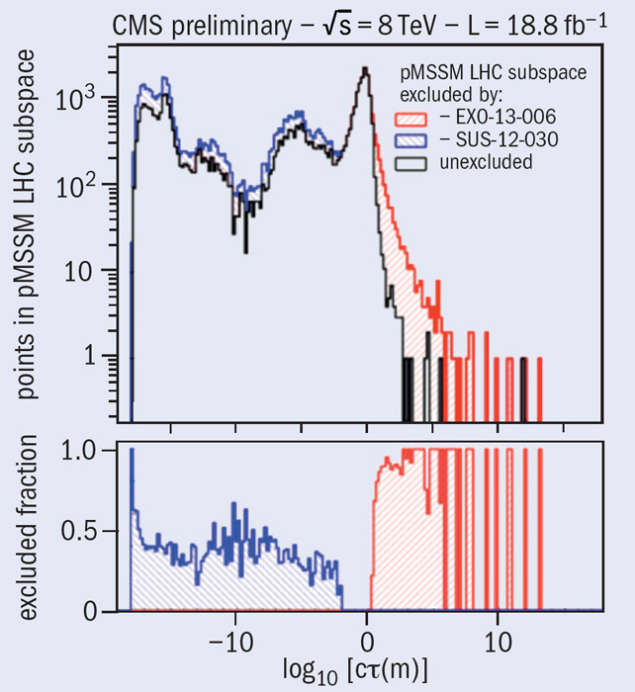As the LHC experiments improve the precision of their measurements of Standard Model processes, the extent of possibilities for new physics open to exploration is becoming ever more apparent. Even within a constrained framework for new physics, such as the phenomenological minimal supersymmetric standard model (pMSSM), there is an impressive variety of final-state topologies and unique phenomena. For instance, in regions of the pMSSM where the chargino–neutralino mass difference is small, the chargino can become metastable and exhibit macroscopic lifetimes, potentially travelling anywhere between a few centimetres and many kilometres before it decays. An experiment like CMS can identify these heavy stable charged particles (HSCPs) through specialized techniques, such as patterns of anomalously high ionization in the inner tracker, as well as out-of-time signals in the muon detectors.

The CMS collaboration recently released a reinterpretation of a previously published search for HSCPs that used these techniques to constrain several broad classes of new physics models (CMS 2013a). There are two purposes for this reinterpretation. The first is to provide a simplified description of the acceptance and efficiency of the analysis as a function of a few key variables. This simplified “map” allows theorists and others interested to determine an approximate sensitivity of the CMS experiment to any model that produces HSCPs. This is an essential tool for the broader scientific community, because HSCPs are predicted in a large variety of models and it is important to understand if the gaps in their coverage are still present.
The second purpose is to provide a concrete example of a reinterpretation in terms of the pMSSM. In this analysis, CMS chose a limited subspace of the full pMSSM, requiring, among other things, that sparticle masses extend only up to about 3 TeV. The figure shows the number of points in this restricted pMSSM subspace that are excluded as a function of the average decay length, cτ, of the chargino. The red points are excluded by the HSCP interpretation described here (CMS 2013b). The blue points are excluded by another CMS search dedicated to “prompt” chargino production (CMS 2012a). The bottom panel shows the fraction of parameter points excluded by each of these two searches. Only a few parameter points, with chargino cτ >1 km, are still not excluded. This is because the theoretical cross-section for these parameter points is small – around 0.1 fb.
This analysis demonstrates the power of the CMS search for HSCPs to cover a broad range of models of new physics. By mapping the sensitivity of the analysis as a function of the HSCP kinematics and the detector geometry, it also makes the results from the search accessible for studies by the broader scientific community.
Although this analysis searches for metastable particles, another open possibility is the production of new, exotic particles that traverse a short distance – around 1 mm to 100 cm – before decaying to visible particles within the detector. CMS has also released results from two searches for such particles. One search looks for decays of these long-lived particles into two jets, and another into two oppositely charged leptons (CMS 2012b and 2012c). The results from these searches exclude production cross-sections for such particles as low as about 0.5 fb, depending on the lifetime and kinematics of the decay.
Further reading
CMS 2013a JHEP 07122.
CMS 2013b CMS-PAS-EXO-13-006.
CMS 2012a CMS-PAS-SUS-12-030.
CMS 2012b CMS-PAS-EXO-12-038.
CMS 2012c CMS-PAS-EXO-12-037.





